
The Battle class were a class of destroyers of the British Royal Navy (RN) and Royal Australian Navy (RAN), named after naval or other battles fought by British or English forces. Built in three groups, the first group were ordered under the 1942 naval estimates. A modified second and third group, together with two ships of an extended design were planned for the 1943 and 1944 estimates. Most of these ships were cancelled when it became apparent that the war was being won and the ships would not be required, although two ships of the third group, ordered for the RAN, were not cancelled and were subsequently completed in Australia.

The 46 Knox-class frigates were the largest, last, and most numerous of the US Navy's second-generation anti-submarine warfare (ASW) escorts. Originally laid down as ocean escorts, they were all redesignated as frigates on 30 June 1975, in the 1975 ship reclassification plan and their hull designation changed from 'DE' to 'FF'. The Knox class was the Navy's last destroyer-type design with a steam turbine powerplant.

The Halifax-class frigate, also referred to as the City class, is a class of multi-role patrol frigates that have served the Royal Canadian Navy since 1992. The class is the outcome of the Canadian Patrol Frigate Project, which dates to the mid-1970s. HMCS Halifax was the first of an eventual twelve Canadian-designed and Canadian-built vessels which combine traditional anti-submarine capabilities with systems to deal with surface and air threats as well. All ships of the class are named after a major city in each province plus the cities of Ottawa and Montreal.
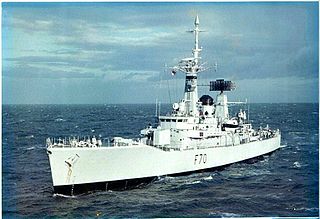
HMS Apollo was a batch 3B broadbeam Leander-class frigate of the Royal Navy. She was, like the rest of the class, named after a figure of mythology. Apollo was built by Yarrow Shipbuilders of Scotstoun. She was launched on 15 October 1970 and commissioned on 28 May 1972, making her the penultimate Leander.

The La Fayette class is a class of general purpose frigates built by DCNS in the 1980s/90s and still operated by the French Navy today. Derivatives of the type are in service in the navies of Saudi Arabia, Singapore and Taiwan.

The Floréal class is a type of light "surveillance frigates" designed for the needs of the French Navy in low-threat environments ordered in 1989. The ships are named after months of the Republican Calendar. They use construction standards of commercial ships. The frigates were built between 1990 and 1993 by the Chantiers de l'Atlantique at Saint-Nazaire, France. The six French ships of the class, Floréal, Prairial, Nivôse, Ventôse, Vendémiaire and Germinal, remain in active service.
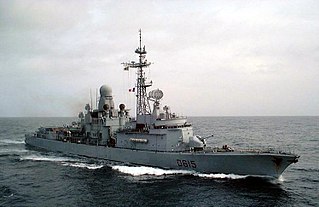
The Cassard class was a class of two anti-air warfare destroyers of the French Navy introduced in the latter 1980s/early 1990s. The class was an air defence variant of the Georges Leygues class. The two classes have a different armament and propulsion system mounted on an identical hull. Their primary role was to provide air cover for a fleet, an aeronaval group, a convoy & a littoral point. Their secondary role was to manage air assets coordination & aircraft control for the force, especially through Link 16.They can also be used for research, identification or presence missions. Both ships were assigned to the Force d'Action Navale. The lead ship of the class, Cassard, was retired in 2019 followed by the retirement of Jean Bart in 2021.

The Suffren class were two anti-air frigates of the French Navy, designed to protect a fleet against air threats, surface ships, and submarines. They were the first French ships to be built specifically as guided missile frigates. Ordered in 1960, the class was intended to be more numerous, but budget pressure from the French nuclear weapons program limited their number. The lead ship, Suffren, entered service in 1967 and the second ship, Duquesne, in 1970. They remained in service until the 2000s when they were replaced by ships of the Horizon class.
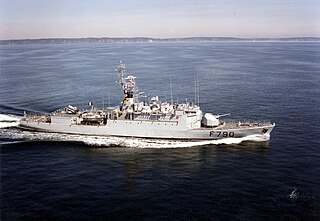
The D'Estienne d'Orves-class avisos, also known as the A69 type avisos, is a class of avisos, comparable in size to a light corvette, mainly designed for coastal anti-submarine defence, but are also available for high sea escort missions. Built on a simple and robust design, they have an economical and reliable propulsion system which allows them to be used for overseas presence missions. They were initially intended for use by the French Navy, but have been ordered by the South African Navy, Argentinian Navy and Turkish Navy.

French Navy modernization is pursued on the basis of successive Projet de loi de programmation militaire. These defence modernization plans are formulated on a rolling basis pursuant to strategic, political and budgetary factors and pressures. Current program modernizations are anchored in the commitment to replace the aircraft carrier Charles de Gaulle with a new nuclear-powered aircraft carrier as well as in the commitment to maintain an ongoing force of at least 15 large frigate/destroyer sized ships.

The Commandant Rivière class was a class of frigates built for the French Navy in the late 1950s and early 1960s. Labeled "aviso-escorteur", they were designed to perform the role of overseas patrol in peacetime and anti-submarine escort in wartime. This vessel class is named after the French Navy officer Henri Rivière (1827–1883).

The T 47 class or Surcouf class were the first destroyers built for the French Navy after the Second World War. Twelve ships were built between 1955 and 1957. The ships were modernised in the 1960s and decommissioned in the 1980s, when they were replaced by the Cassard and Georges Leygues-class frigates. The class was authorised in 1949 and were designed as aircraft carrier escort vessels. Three were modified to become flagships, four became anti-air guided missile destroyers and five became anti-submarine destroyers. One member of the class survives, Maillé-Brézé as a museum ship at Nantes.

Aconit was a unique frigate built for the French Navy during the Cold War, in commission from 1973 until 1997. She was named after the corvette Aconit which fought in the Free French Naval Forces during World War II.
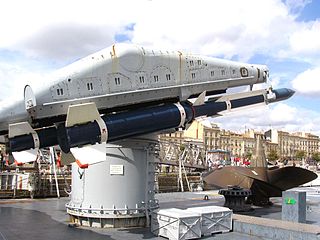
The Masurca missile was a first-generation naval surface-to-air missile system developed and used by the French Navy. Planned as the primary air defence missile system of the first generation of French guided missile ships, it was used only aboard the two Suffren-class frigates and as a retrofit to the cruiser Colbert.

Admiral Tributs is a Project 1155 Large Anti-Submarine Ship of the Russian Navy. Known in the west as an Udaloy-class destroyer, the ship is named after Vladimir Filippovich Tributs. Launched in 1983, Admiral Tributs serves in the Russian Pacific Fleet, and has taken part in operations alongside the naval forces of other nations like China, India and Japan, and as part of a peacekeeping force in the Middle East between 1992 and 1993.
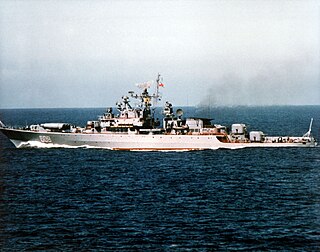
Retivyy was a Project 1135 Burevestnik-class Guard Ship or Krivak-class frigate. With an armament based around the URPK-4 Metel anti-submarine missile system, the vessel served with the Pacific Fleet of the Soviet and Russian Navies. The ship was launched on 14 August 1976 by A.A. Zhdanov in Leningrad, the second of the class built by the shipyard. After joining the fleet, the vessel took part in the search for the crew of the crashed Lockheed P-3 Orion AF 586. In 1981, the vessel sailed as part of a task force along the west coast of the United States to test and measure American defences. Decommissioned on 4 August 1995, the vessel was subsequently sold to a South Korean company to be broken up.
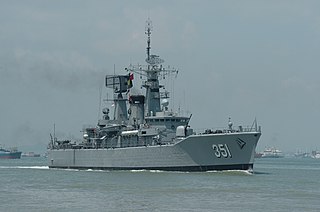
HNLMS Tjerk Hiddes (F804) was a frigate of the Van Speijk class. The ship was in service with the Royal Netherlands Navy from 1967 to 1986. The ship's radio call sign was "PAVC". She was sold to the Indonesian Navy where the ship was renamed KRI Ahmad Yani (351).
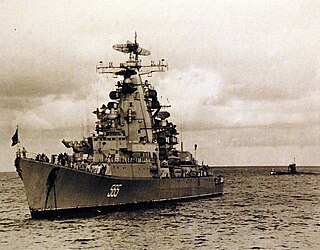
Vladivostok was the second Soviet Navy Project 1134 Admiral Zozulya-class Large Anti-submarine Ship also known as a Kresta I guided missile cruiser. Launched on 1 August 1966, the ship was reclassified a Large Rocket Ship on 3 August 1978 to reflect the wide-ranging capability of the vessel. Serving primarily in the Pacific Fleet during the Cold War, Vladivostok took part in exercises and tours that demonstrated Soviet naval power in the Indian and Pacific Oceans. The ship played a part at a number of points of potential escalation in the Cold War, including the Indo-Pakistani War of December 1971 and the collision between the aircraft carrier Kitty Hawk and the submarine K-314 in March 1984. Vladivostok was taken out of service to be modernised and updated on 28 September 1988 but there were insufficient funds to complete the work. Instead the ship was decommissioned on 19 April 1990 and, the following January, sold to an Australian company to be broken up.

Doblestnyy was a Project 1135 Burevestnik-class Large Anti-Submarine Ship or Krivak-class frigate. With an armament centred on four Metel missiles, the ship was launched on 22 February 1973 and joined the Northern Fleet of the Soviet Navy as a dedicated anti-submarine vessel. Doblestnyy was designated a Guard Ship from 28 July 1977 in response to a change in emphasis of the navy, and subsequently undertook visits to a number of African nations, including Angola and Ghana. Taken out of service to be repaired and upgraded on 19 June 1991, a lack of funding meant that this was cancelled and instead the vessel was decommissioned. The vessel was sold to be broken up on 18 July 1995.

Svirepyy was a Project 1135 Burevestnik-class Large Anti-Submarine Ship or Krivak-class frigate that served with the Soviet Navy. Displacing 3,200 tonnes full load, the vessel was built around the Metel anti-submarine missile system. The ship was launched on 27 January 1971 in Kaliningrad and joined the Baltic Fleet. The ship's service was not restricted to the Baltic Sea and instead travelled widely, visiting a number of foreign friendly ports during the next two decades, including Gdynia, Poland and Havana, Cuba. Svirepyy was designated a Guard Ship from 1977 as Soviet strategy changed to one creating safe areas for friendly submarines close to the coast. However, the ship continued to travel widely, including trips to the capital cities of both Finland and Tunisia as well as Rostock in East Germany. Svirepyy was transferred to the Russian Navy after the dissolution of the Soviet Union, but did not last long before being decommissioned on 30 June 1993 and subsequently broken up.




















